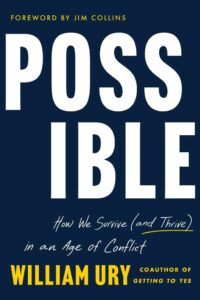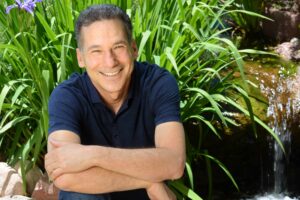How a balcony, a bridge, and third side changes it all
Interview with William Ury
In an era where conflict looms large from personal interactions to global politics, understanding the dynamics of discord and the strategies for resolution has never been more critical.
Enter William Ury. He’s a name synonymous with groundbreaking negotiation strategies. Ury, who has a storied career that includes co-authoring the seminal book Getting to Yes, which has sold over 15 million copies worldwide, is also a co-founder of Harvard University’s Program on Negotiation. His insights have helped resolve complex conflicts from family disputes to international wars.
William Ury’s latest work, POSSIBLE: How We Survive (and Thrive) in an Age of Conflict, arrives as a timely resource amid the divisions of a polarizing election year, ongoing global conflicts, and the disruptive potential of AI technologies. Ury draws from 45 years of experience to chart a new path, advocating for a transformation in how we deal with conflict. He introduces what he calls the “Path to Possible,” which includes strategies such as going to the Balcony for a place of calm, building the Golden Bridge to facilitate cooperation, and harnessing the Third Side to involve the broader community in resolution efforts.
Leaders today face the dual challenge of navigating their teams through external uncertainties and internal disputes. Ury’s book is one that adopts a ‘possibilist’ outlook, viewing conflicts as opportunities for growth.
Critical for Leaders
Why is this book critical for leaders? It equips them to transform toxic confrontations into opportunities for collaboration. As businesses and organizations encounter unprecedented changes and challenges, the ability to steer through conflicts effectively will distinguish successful leaders from the rest.
This book is a must-read for anyone looking to elevate their leadership through effective conflict resolution and to embrace the potential that lies in resolving our deepest differences.
Let’s start with the fascinating conversation you had with your friend and neighbor, Jim Collins. How did that conversation spark this book?
 I am very grateful to Jim. I was taking a mountain hike with him a few years ago when he suddenly turned to me and asked:
I am very grateful to Jim. I was taking a mountain hike with him a few years ago when he suddenly turned to me and asked:
“Bill, our country and our world are in serious turmoil. You’ve been wandering around the world for the last 45 years, working in some of the world’s toughest conflicts from the Cold War to the Middle East, from strikes to boardroom battles. Do you think you could sum up the essence of all you’ve learned in a single sentence?”
Jim’s challenge intrigued me. I gave it some careful thought and on our next hike a few months later, I gave it my best try. Jim looked straight at me and said, “Now go write the book.”
Talk about what gives you inspiration. From that story it’s clear that friends do. And also the outdoors?
It’s true. I absolutely love to take walks in nature, often with friends like Jim. The sheer beauty of nature in all its magnificence is the best antidote, I find, to the stress of conflict. Beauty is my balm. The mountains where I live in Colorado remind me that they have been here and will be here for eons, placing all our human dramas in perspective. Walking, I find, not only relaxes but inspires creative ideas—and a sense of wonder.
Your three-part model is powerful. Talk a little about how leaders can apply the principle of building a golden bridge to navigate workplace conflicts more effectively?
In today’s tough conflicts, we need more than ever to be able to find a way out of the labyrinth of destructive fights. The other side may be far from cooperative. They dig in and refuse to budge. They pressure, attack, and threaten.
Their position, their mind, is far away from yours. There is a huge chasm in between where you are and where they are. That chasm is filled with fear, anger, doubt, unmet needs, distrust. Our challenge is to build a bridge over the chasm—not just an ordinary bridge, a golden bridge. In other words, create an attractive way out for them and for you.
Instead of pushing, do the exact opposite: attract. Instead of making it harder for them, do the exact opposite. Make it easier for them, easier to make the decision you want them to make. Leave your thinking for a moment and start the conversation where their mind is. Listen to them, try to put yourself in their shoes, and figure out their needs and fears so you can address them while advancing your interests, too.
Today we are so split and it seems that the world is more polarized than ever. How can leaders ensure they’re respecting the dignity of others, especially in heated conflicts but still sticking true to themselves?
In heated situations, we are tempted to react and blame the other. The blame game only makes things worse. I like to remember the old saying that “when angry, you will make the best speech you will ever regret.”
In my conflict experience, I have long noticed that the cheapest concession you can make, the one that costs you the least and yields the most, is simply to listen. Truly listen. As hard as it may be, leave your shoes for a moment and try to put yourself in their shoes. Without abandoning what is important to you, see their point of view, hear them. What are their wants and needs, dreams and fears? What does the world look like through their eyes?
Listening not only gives you insight into how others feel and see the situation, but it conveys respect for the dignity of others. You can remain true to yourself and at the same time acknowledge the other’s humanity.
How can leaders apply a broader view to inspire collaboration and solve problems within their teams?
In conflict, we often fall into the trap of reducing everything to two sides — one person vs another, one department against another. Leadership means taking the side of the whole, reminding people of their shared interests, creating a larger context in which people can collaborate to solve their problems. Instead of attacking each other, attack the problem. Encourage people to drop face-to-face confrontation and engage in side-by-side hard-headed joint problem solving.
In leadership, how can saying ‘no’ be just as powerful as saying ‘yes,’ and what are the implications for conflict resolution?
‘No’ may be the most powerful word in the language and potentially the most destructive. But properly used, it can be used to transform conflicts and relationships. No is the key word of clarity. In order to say yes to what is strategically most important, you will have to say no to many other things. How you say no is very important. The key is the positive no which starts with a ‘yes’ — a ‘yes’ to what is truly important to you and your organization. The ‘no’ is not a rejection of others but simply a natural consequence of the ‘yes’. And on the other side of the ‘no’ comes a ‘yes’ — for example, to the ongoing relationship. The no is sandwiched in between two yeses: Yes No Yes.
For a leader trying to steer their organization through change, how should they envision victory in a way that aligns with both their goals and those of their team?
One of my favorite exercises is to write the other person’s victory speech — in this case, the team. Conduct a little thought experiment. Imagine that the team does what you want them to do, as hard as it might be. Now imagine the team explaining to the people they care about why it is actually a victory for them to make the difficult changes. What would be their three key talking points? Then see your job as making it easier for the team to give that victory speech.
What are your hopes for the impact of “Possible” on its readers, particularly leaders and managers dealing with conflict in their organizations?
I hope that “Possible” inspires leaders and managers to escape from the 3A trap of Avoid, Accommodate, or Attack, none of which help solve the problem. Instead, see conflict as something natural and potentially healthy. Lean into it with curiosity, embrace it with creativity, and transform it with collaboration. We can’t end conflict, nor perhaps should we, but we can change the form from destructive fights into creative constructive negotiation. The choice is ours.
And I couldn’t resist throwing in a few others from Getting to Yes. In “Getting to Yes,” you emphasize the importance of separating the people from the problem. Can you give an example of how leaders can effectively implement this strategy in organizational conflicts?
Often we need to be hard on the problem and we end up being hard on the person — for example, in giving critical feedback. Or we make the opposite mistake. We want to be soft on the person and we end up being soft on the problem — we avoid giving clear, honest, useful feedback. What successful leaders do is to combine the two: be soft on the people, hard on the problem. In other words, show respect, listen carefully, and try to put yourself in their shoes at the same time as you directly tackle the difficulties in the way.
You also discuss the concept of focusing on interests, not positions. How can this principle guide leaders in creating more collaborative and productive team environments?
Positions are the things we say we want — the dollars and cents, the target number, the terms and conditions. Interests are the underlying motivations — why we want what we want — the aspirations, desires, needs, concerns, and fears. The way you get at interests is to ask the magic question “why”: “Help me understand why you want to work from home?” As a leader you may not always be able to say yes to a person’s position, like a certain raise, but you may be able to satisfy their underlying interests — in recognition, career development, and greater autonomy.
And finally, your daughter Gabi is an inspiration. (And I have to admit she pushed me to plank longer than ever…to three minutes…how in the world???). So the question…how can everyday people become possibilists or is this only a genetic trait of the Ury family?
That’s amazing that you got to three minutes. I don’t think I can get even to two. The truth is we are all born as possibilists. Take a look at any child — and the way they are always exploring their environments through play. Possibilists see opportunities where it is easy just to see obstacles. They believe in human potential. If you are reading this interview, you are probably a possibilist — interested in improving your leadership. We need to take that same mindset and apply it to our conflicts, looking for new possibilities. If we can transform our conflicts, we can transform our workplaces, our lives, and our world.
For more information, see:
POSSIBLE: How We Survive (and Thrive) in an Age of Conflict Getting to Yes
Image Credit: chris sabor


